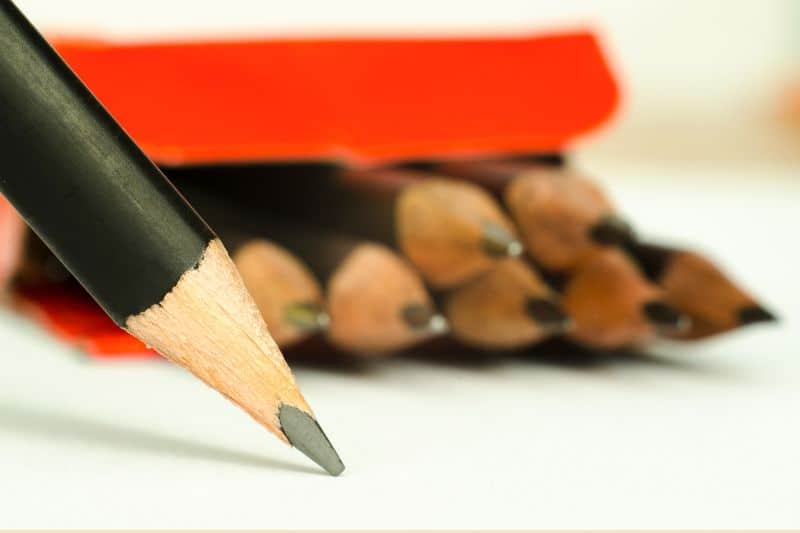As we move forward, let’s dive into the factors that contribute to the weight of a pencil and explore the different types of pencils available on the market today. By the end of our discussion, you’ll have a clearer understanding of how much a pencil weighs and the factors that influence it.
When I first pondered the question, “How much does a pencil weigh?” I wondered if there was a standard weight for pencils or if there were variations depending on the materials used.
Read: How Much Does a Pen Weigh? (Detailed Guide)
Generally, a standard graphite pencil weighs around 6 to 10 grams. Mechanical pencils typically range from 10 to 20 grams. Colored pencils typically weigh around 6 to 10 grams.

Types of Pencils
Graphite Pencils
I have always found graphite pencils a staple in writing and drawing. These pencils consist of graphite and clay encased in a wooden or plastic barrel. Their weight varies based on the size and type of graphite core and the materials used for the casing.

Generally, a standard graphite pencil weighs around 6 to 10 grams. However, there are different grades of graphite pencils, ranging from 9B (the softest) to 9H (the hardest), which can result in slight variations in weight. For example:
- 9B pencils have a softer core, making them slightly lighter.
- 9H pencils have a harder core, leading to a marginally heavier weight.
Mechanical Pencils

On the other hand, mechanical pencils eliminate the need for sharpening, as they use replaceable graphite leads. Since their design is more intricate and consists of metal or plastic parts, their weight typically ranges from 10 to 20 grams.
Mechanical pencils are available in various lead sizes, such as 0.5mm, 0.7mm, and 0.9mm, which may also affect their weight. Here’s a quick comparison of mechanical pencils with different lead sizes in terms of weight:
- 0.5mm pencils: Lighter in weight, easier to handle for detailed work
- 0.7mm pencils: Moderate weight
- 0.9mm pencils: A bit heavier
Colored Pencils

Finally, colored pencils are popular for coloring, sketching, and other artistic endeavors. These pencils comprise a colored pigment core, typically surrounded by a wooden or plastic casing.
Like graphite pencils, colored pencils typically weigh around 6 to 10 grams. The weight may vary slightly based on the materials used and the size of the pigment core. Additionally, colored pencils can be divided into two categories:
- Wax-based pencils: They have a soft, waxy core, making them easier to blend and layer colors. However, they can also be prone to breakage and may be slightly lighter.
- Oil-based pencils: These have an oil-based core, resulting in smoother color application and better durability. They tend to be a bit heavier compared to wax-based pencils.
How Much Does a Pencil Weigh?
I have found that the weight of a pencil can vary based on various factors like the materials used, the type of lead, and the size. Generally speaking, a standard wooden pencil weighs around 6 to 10 grams.
The weight of the pencil may affect how comfortable it is to hold and use, so it’s important to find one that feels right to you.
Different types of pencils can have varying weights due to their construction. For instance, a mechanical pencil may weigh more than a wooden pencil because of the additional parts and mechanisms.
These pencils typically weigh anywhere between 10 to 25 grams, depending on the materials used and the design.
To give you a better idea of pencil weights, here’s a table with some common pencil types and their approximate weights:
| Pencil Type | Weight Range (grams) |
|---|---|
| Standard Wooden | 6 – 10 |
| Mechanical | 10 – 25 |
| Colored Pencil | 7 – 12 |
| Charcoal Pencil | 6 – 10 |
| Watercolor Pencil | 7 – 12 |
How Much Does a Mechanical Pencil Weigh?
When I consider the weight of a mechanical pencil, I find that it can vary depending on its material and components.
Generally speaking, mechanical pencils are somewhat heavier than their traditional wooden counterparts. They often feature additional parts such as erasers, clips, and internal mechanisms that can add to their overall weight.
To give you some concrete examples, let’s look at the weights of a few popular mechanical pencil models:
- Pentel GraphGear 1000: 20 grams
- Rotring 600: 22.7 grams
- Kuru Toga Roulette: 14 grams
- Staedtler 925 25: 19 grams
Please note that these weights are approximate and can vary slightly. Most mechanical pencils’ weight tends to fall within 10 to 30 grams, with heavier ones generally constructed from metal or featuring a more complex internal mechanism.
As you can see, there is quite a bit of variation in the weight of mechanical pencils. Finding the right one is all about personal preferences and balancing factors such as comfort, durability, and overall feel.
A lighter pencil might be more comfortable to hold for extended periods, while a heavier one could provide a more solid, precise writing experience.
How Pencil Weight Varies?

When I first started looking into the weight of pencils, I found that there wasn’t a simple, straightforward answer. Pencils come in different sizes, shapes, and materials, affecting their weight. I decided to explore some factors that cause pencil weight to vary.
One key factor is the type of material used to construct the pencil. Most commonly, pencils are made from wood, but plastic and metal pencils are also available.
A standard wooden pencil weighs approximately 6 to 10 grams (0.2 to 0.35 ounces). A plastic or metal pencil may weigh less or more depending on the material.
The pencil’s diameter also plays a role in its weight. Pencils come in various diameters, from thin ones suited for detailed work to thicker “jumbo” pencils designed for children or those with grip difficulties. As you might expect, a thicker pencil will weigh more than a thinner one, all else equal.
In addition to their overall size, other design elements can affect a pencil’s weight. For example:
- Eraser: An eraser at the end of the pencil can add some extra weight.
- Lead: The thickness and length of the lead core, as well as its composition (e.g., a mix of graphite or charcoal), can contribute to differences in weight.
I also discovered that specialty pencils, such as watercolor or colored pencils, might have unique features that impact their weight. The pigments, binders, and additional materials in the core can cause them to weigh differently than a standard graphite pencil.
Factors Influencing Pencil Weight
When considering pencil weights, I’d like to note that several factors might influence how much a pencil weighs. In this section, I’ll explore some of these factors to give you an idea of what might affect a pencil’s weight.
- Type of Pencil: The first factor that comes to my mind is the pencil type. Pencils come in different variations, such as:
- Wooden pencils
- Mechanical pencils
- Colored pencils

Each type of pencil is made from different materials, which can affect their weight. For instance, wooden pencils are made from wood and graphite, while mechanical pencils contain more metal and plastic components, making them slightly heavier than wooden pencils.
2. Size and Shape: Another factor I’ve noticed is that the size and shape of a pencil can affect its weight. Pencils come in various lengths, diameters, and shapes, such as hexagonal or round barrels.
Generally, longer and thicker pencils weigh more than shorter and thinner ones, regardless of their shape.

3. Materials: The materials used to construct a pencil can also affect weight. As mentioned, wooden pencils are made from wood and graphite, relatively lightweight materials.
However, some pencils, especially certain mechanical pencils, may have metal components or a metal body, making them heavier than their wooden counterparts.

4. Quality: Lastly, I believe that a pencil’s overall quality and craftsmanship can impact its weight. This is because higher-quality pencils tend to use more dense and durable materials, which can result in a slightly heavier pencil.
Moreover, carefully crafted and finished pencils may have a more even weight distribution, providing a balanced feel in the hand.

How to Measure Pencil Weight?
I’ve always been curious about how much a pencil weighs, so I explored different methods to measure pencil weight accurately. In this section, I’ll share a few simple methods that can help you determine the weight of a pencil in a friendly and engaging manner.
The first method I tried was using a digital scale. It’s quite easy to find a digital scale in most households, as they are commonly used for measuring ingredients in the kitchen.
I placed the pencil on the scale’s weighing platform to ensure an accurate reading and noted the weight displayed. Remember to tare the scale before placing the pencil to account for any container you might be using.
Here are some of the measurements I recorded:
- Standard wooden pencil: 6-7 grams
- Mechanical pencil: 10-14 grams
- Colored pencil: 6-8 grams
Another method to measure pencil weight is using a balance scale. A balance scale might be available at your local school, office, or laboratory.
To do this, I placed the pencil on one side of the scale and added small weights to the other side until they balanced out. This gave me an indication of the pencil’s weight.
Read: How Much Does a Nail Weigh? Guide to Nail Weights
When measuring the weight of various types of pencils, it’s essential to remember that the weight can vary depending on factors such as the materials used, the type of eraser, whether it’s a mechanical pencil, and the length of the pencil.
I hope these methods proved helpful in determining the weight of different pencils. So try them out for some fun, hands-on pencil-weight exploration!
Frequently Asked Questions
What’s the average weight of a wooden pencil?
From my experience, the average weight of a wooden pencil is around 6 to 10 grams. Of course, this may vary slightly depending on the size, type of wood, and the amount of graphite inside.
How many grams does a mechanical pencil weigh?
Mechanical pencils weigh more than wooden pencils, ranging from 8 to 20 grams. The weight depends on the materials, such as metal or plastic, and additional features like an eraser or a built-in grip.
What factors influence the weight of various pencil types?
Several factors influence the weight of a pencil. The materials used, such as wood, plastic, or metal, can affect the weight. Additionally, the pencil’s size and shape, the graphite’s amount and density, and any added features like erasers or grips can contribute to the overall weight.
How do pencil weights compare to pen weights?
Pens are usually heavier than pencils because of their metal or plastic bodies and ink cartridges. However, lightweight pens like disposable ballpoint pens can weigh similar to wooden pencils. Fountain and rollerball pens are heavier (15-40g), while ballpoint pens range from 8 to 20g. The weight depends on the model and materials.







